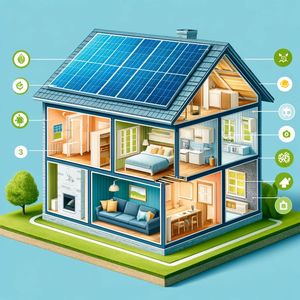Green Homes: How Sustainable Features Are Impacting Property Values
As the world becomes increasingly aware of the importance of sustainability, the real estate market is reflecting this shift in values. Green homes, characterized by their energy efficiency and environmentally friendly features, are gaining traction among buyers and investors alike. This trend is not only driven by a growing eco-consciousness but also by the tangible benefits these homes offer, including lower utility bills, healthier living environments, and, crucially, increased property values.
The Rise of Green Homes
Green homes are designed to minimize environmental impact and improve energy efficiency. They incorporate various sustainable features such as solar panels, energy-efficient appliances, enhanced insulation, and sustainable building materials. These homes often meet or exceed standards set by certification programs like LEED (Leadership in Energy and Environmental Design) and Energy Star.
In recent years, there has been a significant uptick in the demand for green homes. According to a 2023 report by the National Association of Realtors (NAR), homes with green certifications sold for an average of 9% more than non-certified homes. This premium reflects the market’s recognition of the long-term value that sustainable features add to a property.

Financial Incentives and Savings
One of the most compelling reasons buyers are drawn to green homes is the promise of lower utility bills. Energy-efficient homes use less electricity, water, and gas, leading to substantial savings over time. For instance, the U.S. Department of Energy estimates that homeowners can save hundreds of dollars annually by investing in energy-efficient appliances and improvements.
Additionally, many governments and local authorities offer financial incentives to encourage the adoption of sustainable practices. These can include tax credits, rebates, and grants for installing solar panels, energy-efficient windows, and other eco-friendly upgrades. These incentives not only reduce the initial cost of implementing green features but also enhance the overall value of the property.

Health and Well-being
Green homes are not just about saving money and the environment; they also contribute to better health and well-being. Sustainable homes often use non-toxic building materials, improve indoor air quality through better ventilation systems, and incorporate natural lighting. These features can reduce the risk of respiratory problems, allergies, and other health issues, making them particularly attractive to families and health-conscious buyers.
The COVID-19 pandemic has heightened awareness of the importance of healthy living environments. As people spend more time at home, the demand for properties that support physical and mental well-being has surged. This trend is likely to persist, further driving up the demand and value of green homes.

Market Trends and Future Outlook
The trend towards sustainability in real estate is not a fleeting one. Younger generations, particularly Millennials and Gen Z, are increasingly prioritizing environmental responsibility in their purchasing decisions. A 2023 survey by the real estate platform Zillow found that 67% of Millennial homebuyers were willing to pay more for a home with sustainable features.
Moreover, as climate change concerns intensify, regulatory pressures are expected to increase. Governments worldwide are implementing stricter building codes and energy efficiency standards, which will make sustainable features a norm rather than an exception. Homes that already meet or exceed these standards are likely to see significant appreciation in value.

Case Studies
Several case studies highlight the positive impact of sustainable features on property values. For example, a community of green homes in Portland, Oregon, saw property values increase by 15% more than the surrounding area over a five-year period. Similarly, in Austin, Texas, homes with solar panels sold for an average of 4% more than comparable non-solar homes.
These examples underscore the growing recognition of the value that green homes bring to the market. Buyers are increasingly viewing these features not as optional extras but as essential components of a modern, future-proof home.
Conclusion
The shift towards green homes is reshaping the real estate landscape. Sustainable features are no longer a niche interest but a mainstream demand. As more buyers seek out energy-efficient, environmentally friendly properties, the value of green homes continues to rise. This trend is supported by financial incentives, health benefits, and a growing awareness of the importance of sustainability.
For homeowners and investors, this presents a compelling opportunity. Investing in green features not only enhances the value of a property but also contributes to a healthier, more sustainable future. As the real estate market evolves, green homes are set to become a cornerstone of property value, reflecting the changing priorities of today’s buyers and the imperatives of tomorrow’s world.




